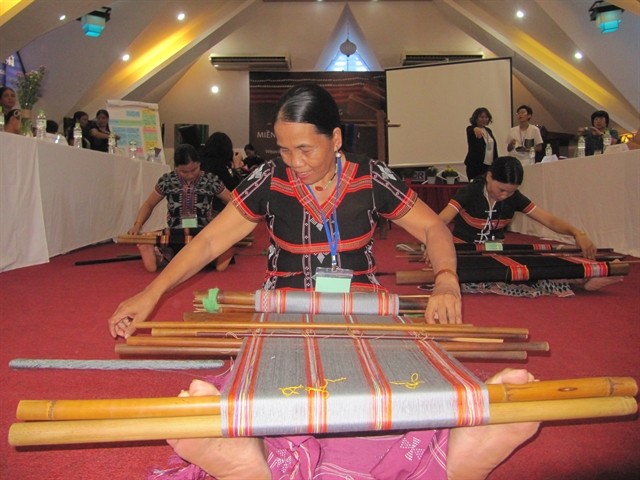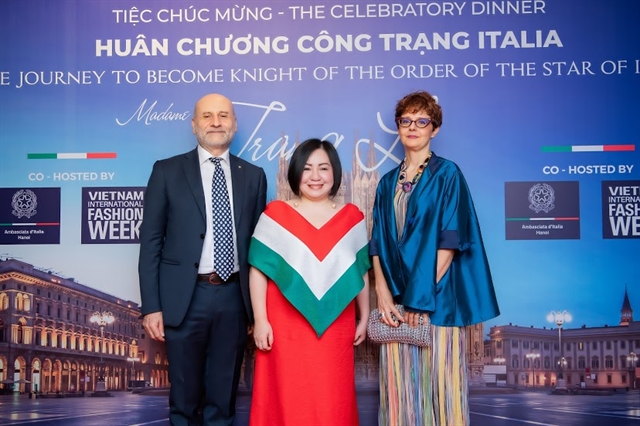 Inner Sanctum
Inner Sanctum

Lê Thị Quỳnh Trang, chairwoman of Vietnam International Fashion Week (VIFW) and President of the Council of ASEAN Fashion Designers (CAFD), talks with Phương Mai about her new plans to promote Việt Nam's fashion industry amid the COVID-19 pandemic, as well as cooperation with the Italian fashion industry.

|
| No Title |
Lê Thị Quỳnh Trang, chairwoman of Vietnam International Fashion Week (VIFW) and president of the Council of ASEAN Fashion Designers (CAFD), talks with Phương Mai about her new plans to promote Việt Nam's fashion industry amid the COVID-19 pandemic, as well as cooperation with the Italian fashion industry.
Inner Sanctum: You are the first person working in the fashion industry in Việt Nam to be awarded the Knight of the Order of the Star of Italy. What have you done to make the two industries in Việt Nam and Italy closer?
Before establishing relations with the Consul General of Italy in HCM City, Dante Brandi, in 2018, I visited Milan in 2014 and 2015 to seek contact with Italian designers, and opportunities for Vietnamese models. I travelled around the world to New York, Paris, Singapore, Japan and South Korea to seek opportunities for Việt Nam fashion. Despite hard work, I always reminded myself of a quote: “Everyone chooses easy work, so who will do the hard one?”
When I took Vietnamese models to Singapore in 2010 after the first season of Việt Nam’s Next Top Model, a TV reality show based on America’s Next Top Model, Singaporean organisers said they had worked in the fashion industry for 30 years but hadn’t seen any Vietnamese models.
I faced more and more challenges in sending Vietnamese models to Paris and Milan. But I knew if I didn’t start my work, there would be no Vietnamese models on catwalks at “capitals of fashion” in the world. This is a way to promote Việt Nam fashion.
Today, with support from foreign commercial agencies and consulates general in Việt Nam, our work has become more “official”. If I want to participate in Micam, the leading international exhibition of the footwear industry, I have help from the Italian Trade Commission to Việt Nam.
We are working on many plans between Việt Nam and Italy.
Let's wait and see at the upcoming VIFW.
Inner Sanctum: What is your 2021 plan, particularly your cooperation with Italy?
VIFW is becoming a bridge to bring Italian fashion brands to Việt Nam.
For example, I’m working with Istituto Marangoni, one of the world’s oldest fashion schools, where famed designers Dolce, Gabbana and Giorgio Armani studied, but very few Vietnamese fashion lovers and those working in the industry know about it.
We have cooperated with Istituto Marangoni for a long time. The school expected to participate in VIFW events, but the work had to be postponed because of the COVID-19 pandemic. We plan to send Vietnamese students to the school when the pandemic is controlled.
We have cooperated with Micam, a very old fashion event. When visiting the event in 2019, I was overwhelmed and felt small.
Fortunately, I had chances to meet Micam organisers who came to Việt Nam right after my trip to Italy to have meetings with Vietnamese footwear manufacturers. Micam also expected to return to Việt Nam and VIFW, but the plan has been postponed again and again due to the pandemic.
In 2020, I planned to bring Vietnamese fashion brand to Pitti Uomo, the world’s most important platform for men’s clothing and accessory collections, but the work had to stop.
However, we realised if we waited for the end of the pandemic, none of our plans would be implemented. So we contacted Italian partners to support us for the upcoming VIFW.
In the framework of VIFW, we expect to host online workshops led by leading fashion experts from Italy to provide Vietnamese fashion lovers and those working in the industry lessons in how to recover from the impact of the pandemic.
It’s hard to meet the editor-in-chief of Vogue Italy magazine but thanks to our Italian partners in Việt Nam, we can contact important partners in Italy.

|
| Lê Thị Quỳnh Trang (centre) and Italian Ambassador to Vietnam Antonio Alessandro and his wife. Photo courtesy of Multimedia JSC |
Inner Sanctum: Is building a digital platform important for fashion development?
Obviously, COVID-19 has caused a crisis in global economics in general, and the fashion industry in particular. However, we admit that COVID-19 has opened up new business opportunities for those who know how to seize the chances.
Applying technologies under different forms helps to narrow the gap between us, saves time, and improves labour efficiency in different fields. For the fashion sector, a digital platform is more necessary. Although there is still a need for dressing well, it has now changed into a new form.
In the past, customers liked to shop at the store, and were focused on sophisticated and luxurious designs despite high prices. Today online shopping is the choice of most of them to ensure their safety, and consumers are also giving priority to re-wearable and affordable designs.
Designers and fashion brands need to quickly adapt and offer designs meeting the needs of customers. Customer services need to be changed by applying new technologies that allow regular interaction and communication with customers. Designers can then retain customers and develop their businesses.
Inner Sanctum: What is your assessment of the role and development of Vietnamese fashion in the Asian and world market?
Before VIFW was first organised in 2014, Vietnamese fashion was less known in Asia and the world. I’m glad that after 10 seasons of VIFW, we have put Việt Nam on the global fashion map, gaining international appreciation. We have advantages over other countries in the region, such as a large market with a population of nearly 100 million. It is a competitive advantage and a potential market not only for the fashion industry, but for all other economic sectors.
In addition, we also have available infrastructure and manufacturing factories because Việt Nam is one of the countries manufacturing products for many international brands. We also have a plentiful and young workforce. Moreover, Vietnamese people’s taste has gradually changed and easily adapted and received new elements.
With all these advantages, Vietnamese fashion has a new and important status in the region and the world. We need to grab this opportunity and “golden moment” to promote Vietnamese fashion’s status and role.
Inner Sanctum: What is your plan to help other Vietnamese designers reach the world market?
Việt Nam has several talented designers who have had no chance to approach the world market. Previously, we created opportunities for designers known from the Project Runway Vietnam contest, such as Hoàng Minh Hà and Lý Giám Tiền, to show their collections on international catwalk.
I realised that our designers’ creativity is not inferior to international designers' work. Many Vietnamese designs were highly appreciated by international customers. However, the major disadvantages of Vietnamese designers when “going out on the high sea” are language skills and ability to access new technologies. The domestic training environment has not created urgency and professionalism in the working style.
In order to help Vietnamese designers catch up with the international fashion market, it is necessary to have organisations like CAFD as a bridge and launchpad to create opportunities for them to experiment and learn about the international market. Hence, I believe the Vietnamese fashion industry will fly much higher in the future. VNS